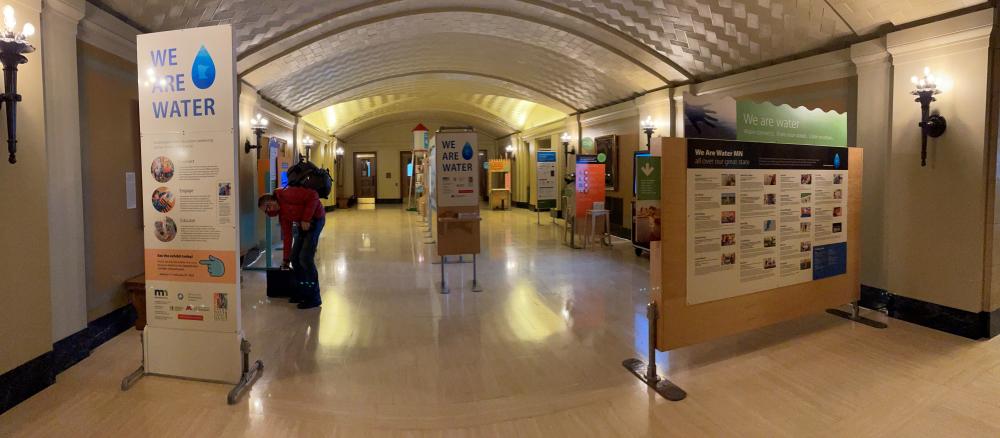We Are Water MN, a traveling exhibit that celebrates Minnesotans’ relationships with water, will be on display at the State Capitol through February 27, 2022.
This exhibit and community engagement program first launched in Spicer, Minnesota, in June 2016, after nearly a year of planning by the Prairie Woods Environmental Learning Center and other local organizations.
Five and half years later, We Are Water MN has visited 20 Minnesota communities in all parts of the state, with five more planned for this year. The personal stories, histories, and scientific information in the exhibit have come together to connect Minnesotans to their state and local waters, expose them to new perspectives, and encourage participation in water stewardship activities. At the capitol, the exhibit celebrates these communities and the more than 450 organizations involved in the local planning.
In Pipestone, exhibit drew connections between water, education, and the arts
Pipestone was the most recent community to host We Are Water MN. In summer 2021, Meinders Community Library embraced the concept of the exhibit and partnered with other local organizations to get residents thinking about their water.
In fact, it was the promise of learning and coming together that first inspired the library to get involved. “Right from the get-go I said, ‘I don’t know enough about this, so I’m going to find the people who do,’” says librarian Jody Wacker.
The library formed partnerships with the Pipestone Area Chamber of Commerce, Pipestone Soil and Water Conservation District (Pipestone SWCD), and the Arts & Mentoring Project (AMP) summer youth theater camp.
The library hosted 800 visitors to the exhibit, which featured water quality projects by the city and agricultural community. The AMP summer youth theater camp also performed Disney’s “Moana, Jr.” at Hiawatha Pageant Park, from July 23 to 25. The camp included lessons about water quality provided by Pipestone SWCD and cultural context lessons from a local community member.
“I didn’t see the connection at first. How could an arts nonprofit be involved in this water exhibit?” says Reggie Gorter, executive producer and director of the performance. “And then I saw how this water-themed performance and the stewardship themes could be a part of this. It became very obvious that this should be part of We Are Water MN. I truly could not have thought of a more perfect connection.”
Special events
Several events are planned by the Minnesota Humanities Center and state agency partners for the current exhibit at the State Capitol, including:
- Feb. 27 (2 p.m.) - A farmer panel hosted by the Minnesota Agricultural Water Quality Certification Program (Minnesota Department of Agriculture). The event will also be live-streamed on the ag department's YouTube channel.
- Feb. 24 (11:30 a.m.) - A free, virtual 90-minute Smart Salting for Local Leaders workshop. Participants will understand the impacts of chloride on infrastructure and water resources and learn about actions and policy changes to reduce salt pollution. This interactive workshop is co-hosted with the Minnesota GreenStep Cities program.
- The Watershed, a weekly podcast featuring stories from We Are Water MN, launched in January. Six weeks of episodes will share stories from the 2020 and 2021 exhibit tour. Find it wherever you get your podcasts.
Visiting the exhibit
Visit We Are Water MN through February 27 in the Capitol’s east corridor, ground level. The State Capitol is open 8 a.m. to 5 p.m. on weekdays. Plan your visit.
More about We Are Water MN
We are Water MN is led by the Minnesota Humanities Center in partnership with the Minnesota Pollution Control Agency; the Minnesota Historical Society; the Minnesota Departments of Agriculture, Health, and Natural Resources; and University of Minnesota Extension.
We are Water MN is funded in part with money from the Clean Water, Land & Legacy Fund — which was created with the vote of the people of Minnesota on November 4, 2008 — and by the National Endowment for the Humanities.
